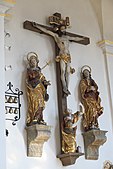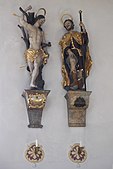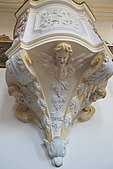St. Martin (Penzing)
The Catholic parish church of St. Martin in Penzing , a community in the Upper Bavarian district of Landsberg am Lech , is essentially a Gothic building that was converted to Baroque style in the early 18th century . The church is one of the protected architectural monuments in Bavaria. The patron saint of the church is St. Martin of Tours .
history
Penzing is one of the oldest parishes in the Landsberg am Lech district. The first pastor is recorded for the year 1055. Around 1469, Baron Philipp Conrad von Pfetten , whose family still has the right of patronage , built a new church. The tower and parts of the masonry have been preserved from this church building. After the destruction during the Thirty Years War , the church was rebuilt. Around 1719, the nave was extended to the west as part of the baroque style of the church . In the 1960s, several extensions were added to the north wall of the nave.
architecture
Exterior construction
The nave and choir are broken through by large arched windows. The corner pilasters are painted on. On the north side, between the choir and the tower, the sacristy covered with a pent roof is attached. The entrances on the north and south sides are integrated in signs . The five-storey bell tower, covered by a gable roof, in the northern corner of the choir is structured by dazzling fields with pointed arch friezes. Ogival sound arcades open up on the bell floor .
inner space
The nave , an undivided hall building , is covered by a flat barrel vault. The retracted choir with a three-eighth closure is covered by a barrel cap. The double gallery standing on supporting columns in the west was built in 1868.
Stucco and ceiling painting
The Wessobrunn stucco décor from 1719 is attributed to Georg Döttl from Dettenhofen. It was partially supplemented in 1921 and 1930/31. The ceiling fresco in the choir depicts Saint Joseph with the baby Jesus and is reminiscent of a brotherhood of Joseph founded in 1712 . The picture was probably painted by Johann Caspar Schäffler around 1770.
Furnishing
- The six-column high altar was built into the church around 1720/30. The altar panel shows the Holy Family , the extract the mantle division of St. Martin. Both paintings were done by Johann Caspar Schäffler. The figures, St. Ulrich and St. Blasius , John the Baptist and Maria Magdalena, as well as the ten angel putti , are attributed to Johann Luidl .
- The two four-column side altars were created around 1740. The figures, like those of the high altar, were created by Johann Luidl. The Jesuit saints Ignatius von Loyola and Stanislaus Kostka stand on the northern side altar, and on the southern side altar are Saint Afra and another, unidentifiable saint. The altar leaves, also made by Johann Caspar Schäffler in 1772, depict St. Wendelin on the left and St. Florian on the right .
- The image of the Virgin Mary painted in oil on canvas on the cafeteria of the north side altar was formerly venerated as an image of grace . Its history can be traced back to the 17th century. It came from Vienna via Burghausen to the Penzinger church.
- The late Gothic wooden crucifix with a life-size figure of Christ on the north choir wall, which originally hung under the choir arch, probably dates from the first half of the 16th century. The assistant figures , a Mother of Sorrows , Maria Magdalena and the Apostle Johannes are probably works by Johann Luidl from around 1730/40.
- The life-size carved figures of Saint Sebastian and Saint Roch on the south wall of the nave were created by Johann Luidl in 1730/40.
- The wooden pulpit , framed in white and stuccoed in color, dates from the first quarter of the 18th century. The underside of the pulpit is decorated with putti heads, the sound cover is crowned by a vase.
- The processional pole with the Madonna and baby Jesus from the late 17th century is attributed to Lorenz Luidl , the processional pole with the figure of Saint Joseph from around 1730/50 is considered the work of his son Johann.
- The choir stalls built into wall niches date from the late 17th century.
- The elaborately carved baroque cheeks of the church pews that were newly erected in 2005 were reused.
Epitaphs
The limestone epitaph on the north wall of the choir is reminiscent of Seboldt Sebastian Höchenkirchner, a boy who died in 1535 at the age of barely nine weeks. Two epitaphs made of red marble are embedded in the southern choir wall to commemorate Benedikt Freiherr von Mändl von Deutenhofen († 1734) and the pastor Michael von Werner († 1805) . The limestone slab on the south wall of the nave for Pastor Gabriel Aukorn († 1758) is decorated with a relief of the crucified Christ and an inscription.
literature
- Georg Dehio: Handbook of German Art Monuments - Bavaria IV - Munich and Upper Bavaria . 2nd edition, Deutscher Kunstverlag, Munich 2002, ISBN 3-422-03010-7 , p. 952.
- Karl Gattinger, Grietje Suhr: Landsberg am Lech, city and district (= Bavarian State Office for Monument Preservation [Hrsg.]: Monuments in Bavaria . Volume I.14 ). Verlag Friedrich Pustet, Regensburg 2014, ISBN 978-3-7917-2449-2 , p. 636-638 .
Web links
Individual evidence
- ^ Parish St. Martin - Penzing Diocese of Augsburg
- ↑ List of monuments for Penzing (PDF) at the Bavarian State Office for Monument Preservation, monument number D-1-81-132-1
Coordinates: 48 ° 4 ′ 33.8 " N , 10 ° 55 ′ 39.6" E













